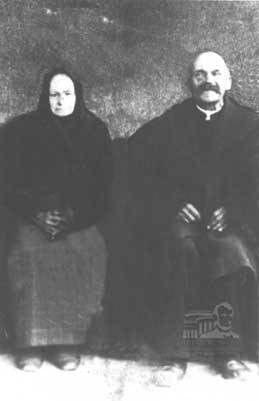Kazimir Ladny is a Polish WW II veteran. He was captured by the Russians in late 1939, spending the winter in a Siberian POW camp. He was then exchanged with the Germans, and spent the remainder of the war as a slave laborer. Liberated in 1945, he struggled to survive, even dabbling in the black market before finally emigrating to America.
Interview Links
Abstract
Interview Session 01 (Audio)
Kazimir's capture Siberian camp
Interview Session 02 (Audio)
From Soviet prisoner to German prisoner
Interview Session 03 (Audio)
From German slave laborer to liberation
Interview Session 04 (Audio)
Two Kazimirs reunite
Transcript
Videos
Photos

Caption
Kazimir's paternal grandparents, Karol Ladny and Teofila Mandra Ladny.
Where:
Unknown
When:
Unknown
Ownership:
Narrator's photo.

Caption
Young Kazimir Ladny before the war.
Where:
Unknown
When:
Unknown
Ownership:
Narrator's photo.

Caption
Kazimir's older brother, Karol, and his son, who was named after his uncle Kazimir. Karol had presumed that his brother Kazimir was dead at the time of his son's birth.
Where:
Unknown
When:
Unknown
Ownership:
Narrator's photo.

Caption
Kazimir in his uniform in 1937. He served with the Polish Army Signal Corps, with the 30th Poleska Infantry Division.
Where:
Unknown
When:
1937
Ownership:
May be restricted. Patrons desiring to use this photograph should contact the original copyright holder. The ALPL Audio-Visual Archivist can assist you in this regard.

Caption
Wedding portrait for Kazimir and Adele (Lambertz) Libertus, on the occasion of their church wedding on June 23, 1945.
Where:
Unknown
When:
June 23, 1945
Ownership:
Narrator's photo.

Caption
Kazimir and Adele with Kazimir's Polish friend and his new bride on their wedding day.
Where:
Unknown
When:
Unknown
Ownership:
May be restricted. Patrons desiring to use this photograph should contact the original copyright holder. The ALPL Audio-Visual Archivist can assist you in this regard.

Caption
Kazimir whittled this pipe while a POW in Oranki, Siberia, and later carved the case while in Germany. These were two of his precious few possessions he managed to retain throughout the war.
Where:
Unknown
When:
Unknown
Ownership:
Narrator's photo.

Caption
The pipe Kazimir whittled while a POW in Siberia.
Where:
Unknown
When:
Unknown
Ownership:
Narrator's photo.

Caption
Kazimir on the left with fellow prisoner Leo Goreczny at the Henkel farm in Wildberg. Herr Henkel treated his prisoners humanely.
Where:
Henkel farm in Wildberg
When:
Unknown
Ownership:
Narrator's photo

Caption
Kazimir, Felix Kaschubowski and an unidentified friend in Dusseldorf shortly after the war.
Where:
Dusseldorf
When:
Unknown
Ownership:
Narrator's photo.

Caption
Kazimir and fellow POWs take a rare Sunday outing in Wildberg. Kazimir is in the front row, left, wearing a suit sent to him by his father. Note the badges on the right side of their suits, designated “P” for Polish POW.
Where:
Wildberg
When:
Unknown
Ownership:
Narrator's photo.

Caption
Kazimir's identity card issued following his liberation in 1945.
Where:
Unknown
When:
Unknown
Ownership:
Narrator's photo.

Caption
A note from the commandant of the Displaced Persons Camp following the war, granting Kazimir permission to leave. The seal belongs to the 6th Battalion Royal Welch Pusiliers.
Where:
Unknown
When:
Unknown
Ownership:
Narrator's photo.

Caption
Kazimir Ladny and Kazimir Tafil. Childhood friends, both were in WWII, and each thinking the other had died in the war, met after 60 years in Siedlce, Poland.
Where:
Unknown
When:
Unknown
Ownership:
Narrator's photo.

Caption
Tafil, when he was 15, was taken to Auschwitz with 3 older brothers who were killed there. The brothers were more educated, but only Kazimir survived.
Where:
Siedlce, Poland
When:
Unknown
Ownership:
Narrator's photo.

Caption
Kazimir Ladny and Kazimir Tafil standing in front of the chapel that Tafil built on his property in Siedlce, Poland. Tafil built the chapel to give thanks for his survival through the "hell on earth" that was Auschwitz.
Where:
Siedlce, Poland
When:
Unknown
Ownership:
Narrator's photo.

Caption
The altar inside Kazimir Tafil's chapel where mass could be held. The picture on the left depicts a priest who was also a prisoner at Auschwitz.
Where:
Siedlce, Poland
When:
Unknown
Ownership:
Narrator's photo.

Caption
Kazimir Tafil showing Kazimir Ladny and Mary Efin photos outside Tafil's chapel in Siedlce, Poland. Narrator’s photo.
Where:
Siedlce, Poland
When:
Unknown
Ownership:
Narrator's photo.

Caption
Plaques at the chapel in Siedlce, Poland reading “God Honor Fatherland” and “In Memory”.
Where:
Unknown
When:
Unknown
Ownership:
Narrator's photo.

Caption
Plaque at the chapel in Siedlce, Poland reading: “Project and Builder, Kazimierz Tafil. Thankful to God for my survival through this hell on earth in Auschwitz, 1941-1945.”
Where:
Unknown
When:
Unknown
Ownership:
Narrator's photo.

Caption
Kazimir Tafil and a friend discussing his experiences.
Where:
Unknown
When:
Unknown
Ownership:
Narrator's photo.

Caption
Stanislaw Ivanowski, Kazimir Tafil, Mary Eglin, and Kazimir Ladny on August 19, 2002, standing in front of the chapel built by K. Tafil in Siedlce, Poland.
Where:
Siedlce, Poland
When:
August 19, 2002
Ownership:
Narrator's photo.